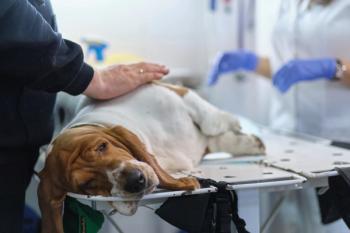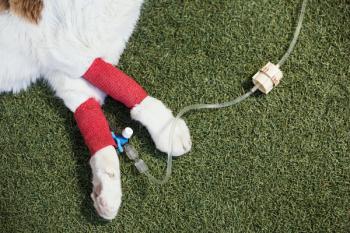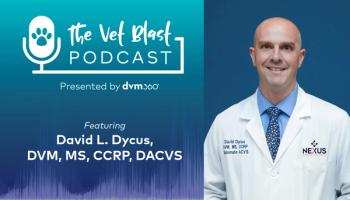
Pet food crisis
National Report - A tidal wave of telephone calls from worried pet owners flooded veterinary practices nationwide last month after nearly 1 percent of all the pet food sold in the United States was recalled and later reported to have been contaminated with a rodent-killing toxin.
NATIONAL REPORT — A tidal wave of telephone calls from worried pet owners flooded veterinary practices nationwide last month after nearly 1 percent of all the pet food sold in the United States was recalled and later reported to have been contaminated with a rodent-killing toxin.
New York State Agriculture Commissioner Patrick Hooker and Cornell University's College of Veterinary Medicine Dean Donald F. Smith announced at a March 23 press conference in Albany, N.Y., that scientists at the New York State Food Laboratory identified the presence of the rodenticide aminopterin in pet-food samples from Ontario-based Menu Foods Inc., which produced the 95 brands of pet food recalled on March 16.
The recovery effort: Dr. Kari Swedenborg, DVM, part owner of West Park Animal Hospital in Cleveland, Ohio, cares for Molly, a client's cat suffering symptoms of renal failure after consuming one of the pet foods on the nationwide recall list.
Aminopterin, illegal for use in the United States as a rat poison, was used to treat human cancer patients in the 1950s but has not been in mainstream use for decades, so relatively little is currently known about its effects, says Dr. Steven Hansen, an official with the American Society for the Prevention of Cruelty to Animals Poison Control Center (see story). It is linked to some conditions, including diarrhea, leukopenia, anorexia, progressive weight loss, dehydration, ileitis, ulcerative colitis and birth defects, but whether it causes kidney failure – the chief concern in pet deaths tied to the food recall – is still unknown, Hansen says.
In a press release, the poison-control center said that, while "we do not know if aminopterin can cause renal failure in pets, ... the ASPCA does not recommend any change in treatment of animals affected; animals currently being treated for kidney failure suspected to be related to the ingestion of the contaminated food should stay on such treatment. Please follow your veterinarian's advice."
The Food and Drug Administration (FDA) had not determined that aminopterin was the cause of 16 animal deaths it had confirmed at press time.
How the substance got into the pet food, whether it was the only contaminant and whether it was used in sufficient quantity to kill or sicken still more animals was not immediately clear.
Veterinarians inundated with calls from worried clients referred those whose pets didn't show symptoms warranting an immediate office visit to the Menu Foods Web site,
Pet-food makers issue voluntary recalls
Telephones were ringing
The American Veterinary Medical Association (AVMA) received "perhaps 10 times the usual number of calls from members, the media and pet owners," says Michael San Filippo, an AVMA media-relations assistant. The AVMA responded by posting advice to DVMs and pet owners on its Web site, and continues to update both as new information becomes available.
New York City's Animal Medical Center also was swamped with calls about the recall and its laboratory performed twice the normal number of urine and blood tests at the request of concerned pet owners.
"The actual caseload wasn't up that much, but there were a lot of worried clients," says Michael Shepley, a spokesman for the center. "The first weekend after the recall, our waiting room was packed on a Sunday evening, although only three cases out of that group were actually related to the recall. Our lab tests doubled, and our dispensary caseload was up 50 percent."
It was the same story at animal hospitals and private practices around the country – a virtual tsunami of telephone calls from worried clients, a spike in the number of laboratory tests, but a limited number of actual cases of renal failure linked to the tainted pet food.
Kari Swedenborg, DVM, part owner of West Park Animal Hospital in Cleveland, Ohio, says her facility was "packed with clients during the first days after the recall. Business over that weekend – we're open seven days – was up perhaps 20 percent to 30 percent. Our staff also responded to tons of calls. Mostly we referred people to the Web site for the recalled foods, but suggested that they bring animals in for testing if they had concerns or the animals showed any symptoms of renal problems. Many clients did come in, so we performed a large number of lab tests – blood work, urine tests, ultrasound."
Swedenborg's hospital has 50 employees, including seven DVMs on day shift and two DVMs on emergency duty.
One of them, Kane Henderson, told a local newspaper reporter that "in my 11 years here I've never seen anything so massive as this."
One couple brought in five cats suffering acute kidney failure; the animals were given fluids, had ultrasounds of their kidneys, plus multiple blood tests, but the owners said the cost was not a concern to them. "Our pets are our kids," they told the newspaper.
Swedenborg says she feeds her own cats dry foods and recommends dry food to clients.
Former cancer drug a deadly toxin?
Only 'wet' foods recalled
The tainted products that Menu Foods Inc., a private-label pet-food manufacturer in Mississauga, Ontario, recalled were the wet variety – "cuts and gravy" style cat and dog food products produced at its Kansas and New Jersey facilities between Dec. 3, 2006, and March 6, 2007.
Steva Stowell-Hardcastle, DVM, who operates Companion Animal Hospital in Selinsgrove, Pa., says her office, too, handled "many, many calls, but we saw only a couple of suspected cases involving the suspected foods. One owner saved the package, so that confirmed it; another didn't save the package but knew that the animal was fed one of those products. Both had symptoms. In addition we were quite busy doing kidney screenings – six or seven of them on one day, and a few more later.
"Later we made copies of all the cat foods and dog foods on the list and handed them out to clients."
Jennifer Ann De Meo, a practitioner in Atlantic Highlands, N.J., reports receiving lots of calls from anxious clients, most of whom she referred to Menu's recall Web site.
A staff member at Westchester Veterinary Hospital in High Point, N.C., recalls that "about one of every three calls we had during that period pertained to the recall, but there weren't many actual cases. We gave them the Web site; we recommend dry foods to all our clients."
A Gayton Animal Hospital spokesman in Richmond, Va., also reports referring many callers to the Web site and says that two pets exhibiting some symptoms of renal problems were brought in.
Decatur, Ga., practitioner Dr. Will Draper told the Associated Press he was swamped with so many e-mails and telephone calls that he produced a newsletter on the subject and e-mailed it to all his clients, saying "it helped tremendously. It has calmed clients."
Dr. Thomas Mullaney, acting director of the Diagnostic Center for Population and Animal Health at the Michigan State University College of Veterinary Medicine, which also received numerous calls, said autopsies performed on four dogs and one cat during one week last month "revealed signs of renal disease that in my opinion were related to the recalled food."
Initial deaths prompted recall
The scare began after nine cats and one dog died of renal failure within a few days of consuming the moist foods at a Menu Foods taste trial in late February. Earlier complaints had prompted the trial, and the trial results led to the recall.
By mid-March, at least six more pet deaths were confirmed by the AVMA and the FDA, bringing the total to 16.
The recall initially involved 60 million cans and pouches of food sold in the United States, Canada and Mexico under 50 brand names of dog food and 45 brands of cat food. (That represents nearly 1 percent of the total pet foods sold in the United States.) Brands include Iams, Science Diet, America's Choice, Preferred Pets, Eukanuba and Nutriplan. The products were sold by Ahold USA, Kroger Co., Safeway, Wal-Mart Stores Inc., PetSmart Inc and Pet Valu Inc.
On March 24, Menu Foods asked stores to remove all of its "cuts and gravy" style food from shelves, regardless of manufacturing date, to ensure that no suspect foods inadvertently remained.
"There is no known risk from items not on the recall list, but an abundance of caution is called for in this situation," the company says.
By press time, at least four private lawsuits reportedly were filed by pet owners.
People for the Ethical Treatment of Animals (PETA) stated on its Web site that, "We're calling on prosecutors to investigate whether cruelty charges should be filed against Menu Canada, Menu Foods and Iams for alleged failure to warn consumers about the tainted food as soon as they had the information and – just as disturbingly – apparently feeding the tainted food to cats and dogs in order to test it."
Another aspect of the scare concerns how well pet-food production is regulated in the United States.
Newsweek magazine reported that FDA officials "admit that the regulation of pet food is not high-priority, and that inspections of processing plants are done only on a 'for-cause' basis." It quoted David Elder, director of the Office of Surveillance and Compliance in the FDA's Center for Veterinary Medicine in Rockville, Md., as saying that "resources are limited" and that inspections of pet foods are "based on risk." Elder did not return a call from DVM Newsmagazine about FDA's inspection priorities by press time.
AMC lab statistics revealing
Dr. Ann E. Hohenhaus, chairman of the Animal Medical Center's Department of Medicine and Dr. Catherine Langston, of AMC's Renal Medicine Service, in a March 22 news release, provide the results of renal chemistry profiles at the hospital between March 17 and March 20.
"During this time, 143 profiles were performed, and 5 percent of the pets who had a chemistry profile in that period have been determined to have food-related acute renal failure. AMC has identified 12 cases of food-related renal failure, eight cats and four dogs. Age range was 2 to 14 years," the release states.
"Based on this survey, we can provided the following limited information: All pets had at least one clinical sign of acute renal failure: 75 percent had anorexia, 50 percent had polyuria and polydipsia, 50 percent had vomiting and 50 percent lethargy."
Langston advises DVMs with clients whose pets consumed the tainted food that "a urine specific-gravity test is a quick and easy screening for acute renal failure. If the specific gravity is more than 1.035 for cats and 1.030 for dogs, acute renal failure is not the diagnosis. If it is less than these values, a chemistry profile should be evaluated to determine if the pet is azotemic.
"Intravenous fluids should be administered if the pet is symptomatic for acute renal failure. Hemodialysis is indicated in pets with worsening creatinine despite adequate fluid therapy, oliguira, anuria, hyperkalememia or intractable signs of uremia."
Newsletter
From exam room tips to practice management insights, get trusted veterinary news delivered straight to your inbox—subscribe to dvm360.





